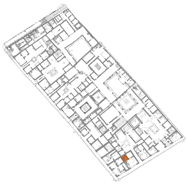Room 5
Description
Susanna Blåndman
Room 5 is located in the northwest corner of the taberna and today there is no threshold or other architectural boundary to room 3. On the west wall there is however traces of a transverse wall and a beam hole in the upper half. These remains together with five beam holes on the north wall show that room 5 had an upper floor. There are no traces of a transverse wall in the lower part of the west wall and a feature is located at the point just below the beam hole on the west wall. There is no corresponding beam hole on the east wall since the east wall is reconstructed in that area. If the remains of the transverse wall are used as a border between room 3 and 5, the size of room 5 is approximately 7.4 m2, making it the smallest of the three rooms.
None of the walls are standing to full height and all walls are reconstructed to some extent. Several features were found in room 5, located in the west and in the north part; two features along the north wall are yet not identified. Along the north wall we found a drain, a cistern and along the west wall remains of what could be a small basin.
Room 5 has several remains of eruption debris. Ash and lapilli in three of the beam holes in the north wall and in the larger beam hole on the west wall indicate the collapse of the ceiling, and thereby the roof, during the eruption. This is also showed by the remains of debris in recesses on both the east and the west walls. Eruption debris attached to the remains of the transverse wall indicates the falling of the transverse wall in connection with the eruption.
Among the features in room 5 the drain in the northwest corner had a layer of hardened ash in the bottom and it was clear that the drain was in use in AD 79. The cistern had a layer of lapilli, at least 0.30 m thick at the depth of 0.70 m, which means that the cistern was not closed during the eruption.
Relationship between the studied walls and floor surfaces in room 5
The east wall of room 5 is built at the same time as the north wall of room 3. The corner of the walls is built as a coherent unit. This corner is reconstructed in modern times from approximately 1.85 - 2.00 m and upwards. The east wall abuts on the north wall of room 5. The corner between the west and the north walls is completely covered by mortar except for a part below the lower band of bricks. In that area the west wall seems to continue behind the north wall, which is also the case with an arch located in this area of the west wall. The west wall continues into room 3. There are no remains of floor surfaces in the immediate vicinity of the walls.

